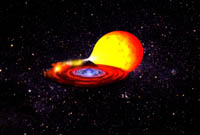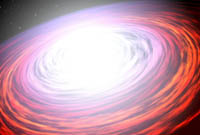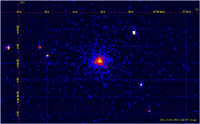RXTE Discoveries
Three Satellites Discover One Elusive Star - November 2005
An international team of scientists has uncovered a rare type of neutron star so elusive that it took three satellites to identify it. The discovery highlights the complementary nature of European and U.S. satellites to reveal new insights about star birth and death in our galaxy.
The neutron star, an ultradense ember of an exploded star, was first seen by the European Space Agency's International Gamma Ray Astrophysics Laboratory (INTEGRAL) satellite. The neutron star is in a "double hiding place," the INTEGRAL scientists said. It is deep in a spiral arm of our Milky Way galaxy, obscured by dust, and is buried in a two-star system enshrouded by dense gas.
Because scientists couldn't immediately decipher the nature of the object, they enlisted the help of NASA's Rossi X-ray Timing Explorer and the newly launched Swift satellite to observe it in different wavelengths.
"Our galaxy's spiral arms are loaded with neutron stars, black holes and other exotic objects," said Dr. Volker Beckmann of NASA Goddard Space Flight Center in Greenbelt, Md., lead author on a paper appearing in the Astrophysical Journal. "The problem is the spiral arms are too dusty to see through. The right combination of X-ray and gamma-ray telescopes can reveal what's hiding there and this provides new clues about the true star formation rate in our galaxy."
Neutron stars are the core remains of supernovas, exploded stars once about ten times as massive as the Sun. They contain about a sun's worth of mass compacted into a sphere of just about 15 miles across. The subject of this study is a neutron star called IGR J16283-4838 in the direction of the spiral arm Norma, about 50,000 light years away. IGR J16283-4838 is the seventh so-called "highly absorbed," or hidden, neutron star that scientists have identified. Neutron stars, born of fast-burning massive stars, are intrinsically tied to star formation rates. They are also energetic beacons from a region too dusty to study in detail otherwise. "As more and more are discovered, new insights about what is happening in the galaxy's spiral arms begin to emerge," Beckmann said.
IGR J16283-4838 revealed itself during an outburst on or near its surface. Neutron stars such as this are often part of binary systems, orbiting a normal star. Occasionally, gas from the normal star, lured by gravity, crashes onto the surface of the neutron star and releases a great amount of energy. Outbursts can last for weeks before the system returns to dormancy for months or years.
INTEGRAL, the Rossi Explorer and Swift all detect X-rays and gamma rays, which are far more energetic than the visible light our eyes can see. Yet each satellite has different capabilities. INTEGRAL has a large field of view, enabling it to scan the Milky Way galaxy for neutron star and black hole activity. Swift contains a high-resolution X-ray telescope, which allowed scientists to zero in on IGR J16283-4838. The Rossi Explorer has a timing spectrometer, a device used to uncover properties of the light source, such as speed and rapid variations on the order of a millisecond.
Simona Soldi, a doctoral candidate at the INTEGRAL Science Data Centre in Geneva, discovered the new bright source on April 7 using the spacecraft. "We are always hunting for new sources, and it's exciting when we find something so elusive," Soldi said. "How many more like this are out there?"
Because gamma rays are hard to focus into sharp images, the science team used the X-ray Telescope aboard Swift on April 13 and 15 to determine a precise location. Swift confirmed that the light was "highly absorbed," which means the binary system was filled with dense gas from the stellar wind of the companion star. Starting on April 14, scientists used the Rossi Explorer to observe the source as it faded away. This observation revealed a familiar light signature clinching the case for a fading "high-mass X-ray binary" with a neutron star.
"Piece by piece we solved this puzzle," said Dr. Jamie Kennea, Swift science team member at Penn State. "Swift was built primarily to detect gamma-ray bursts, so it was a thrill to use the X-ray Telescope to do something quite different, to discover a neutron star."
INTEGRAL launched in 2002, and the Rossi Explorer and Swift launched in 1995 and 2004, respectively.





